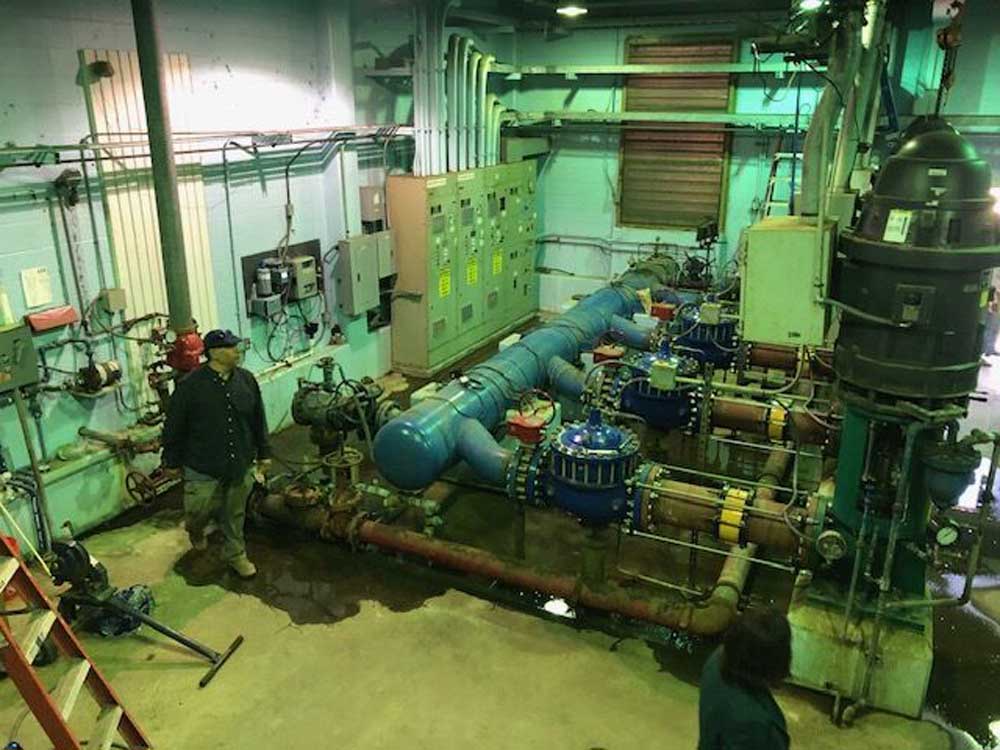Network of new water pipes at Warm Springs could cost millions
Published 5:00 pm Monday, May 22, 2023

- Ron Palmer, plant engineer and operator, looks at the workings in the water treatment plant in Warm Springs on Monday.
For years the Confederated Tribes of Warm Springs have been patching and repairing the aging system of pipes that convey water across their reservation to businesses, homes, and offices. Ripping out the old pipes and installing a new, upgraded system could cost tens of millions of dollars.
That’s according to Chico Holliday, the tribes’ public utilities general manager. Speaking on the sidelines of a press conference on the Warm Springs Indian Reservation on Monday, Holliday said main waterlines are in good condition but the branches from the main lines are still leaky and at risk of failure.
“The branches have an additional $30 to $40 million worth of work that we are going to have to come up with for those projects,” said Holliday.
“We have been actively seeking funds for those projects since 2017.”
Warms Springs operates on decades-old infrastructure to convey water to the approximately 4,000 reservation residents.
Some of the pipes are made from wood and terracotta and date back to the 1960s when the system was first installed.
“We just closed down a 150-foot section of wooden pipe, but we still have terracotta pipe, sewer pipe, asbestos water mains, we also got Orangeburg piping for sewer lines that we are constantly finding and repairing. There are also galvanized and steel pipes,” he said.
Orangeburg pipes, commonly used from the 1940s until the 1970s, were made from cellulose and asbestos fibers impregnated with a coal tar compound. They were supplanted with the rise of PVC piping.
Failures of the Warm Springs underground pipes and water treatment plant have caused repeated boil water notices on the reservation in recent years. Some of the boil water notices have stretched for weeks and even months, forcing area residents to collect plastic jugs of water from the reservation’s emergency services center.
Holliday said he is seeking federal funds for the piping projects and he anticipates that funding will come in phases over a 10- to 15-year period. One of the projects, to repair a section of pipe under Shitike Creek, will cost $2.2 million, he said.
Capt. Alex Dailey, director of the Division of Sanitation Facilities Construction for the Indian Health Service in Portland, said there is “no specific number in mind” in terms of how much piping will be replaced but the issues will be addressed on a case-by-case basis.
In addition to the millions needed to repair the network of pipes, Warm Springs also plans to build a new water treatment facility that will cost around $24 to $25 million, said Holliday. Inflation costs could increase that number another $10 to $12 million higher, he said.
The current facility is undergoing an $11 million repair and renovation project to hold the system together until the new building can be constructed at the same location, said Holliday.
Holliday said the renovation work is currently underway and will wrap up by the end of the year. The work includes the recent replacement of 27 water pressure control valves.
At the press conference on Monday, Holliday helped lead a delegation of visitors around the current, 41-year-old water treatment plant. He and plant engineer and operator Ron Palmer showed off some of the ongoing repairs and details of the new plant.
Among the visitors were Oregon senators Jeff Merkley and Ron Wyden, on hand to tout $28 million in federal investments they helped to secure to build the new water treatment plant. The building is expected to take four to five years to design and build.
Wyden added that new laws, laid down in the Western Tribal Water Infrastructure Act, will help cut through red tape to help fast-track funding for water infrastructure for not just Warm Springs but other tribes in the United States.
Among the multiple funders of the new facility at Warm Springs, most of the money comes through the Indian Health Service, which is putting in $14 million for the new plant. The Environmental Protection Agency is contributing $10.3 million.
“There is a shameful legacy right here in this spot of Oregon, these pipes, the boil water notices, year after year of failing water treatment for the tribes, the families, and all concerned,” said Wyden, speaking to reporters from the banks of the Deschutes River, behind the current treatment plant.
“Members of the Confederated Tribes have waited far too long for something that ought to be a basic human right, the right to secure clean water. We have to acknowledge the shameful history.”






